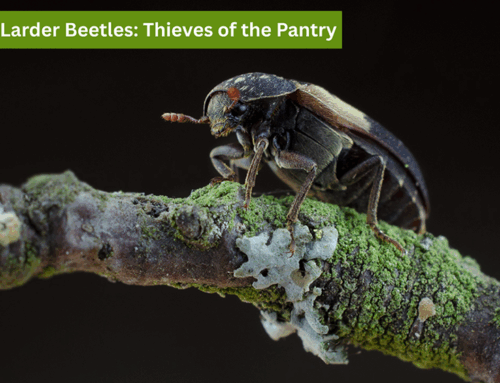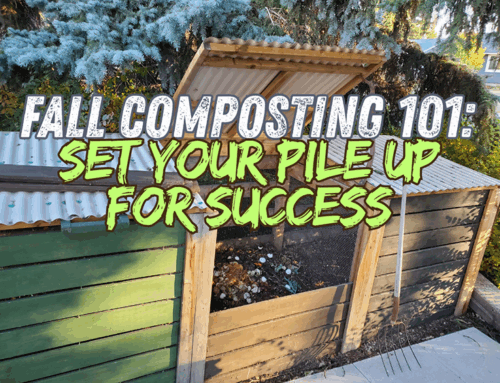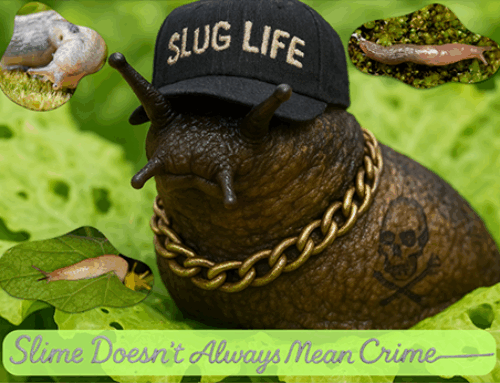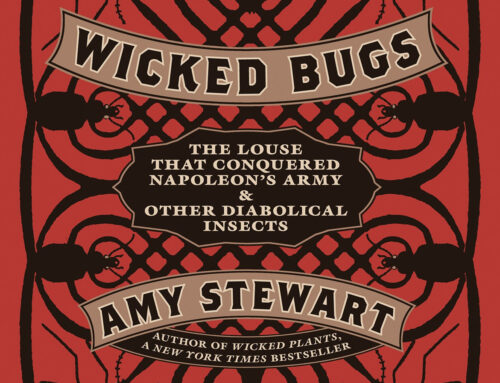Tiny Terrors: Attack of the Garden Mites
by Brett Kerley
Gardeners encounter a variety of pests, but among the smallest and most troublesome are mites. These tiny arachnids can cause significant damage to plants if left unchecked. Understanding their behavior, identifying infestations, and knowing how to manage them are crucial for maintaining a healthy garden.
The Acari are a sub-class of the class Arachnida and are more commonly known as the mites and ticks. Ticks are exclusively ectoparasitic (parasites that live on the external surface of hosts) but there are both free living and parasitic mites. As of the most recent update (August 2021), there are about 1,375 species of mites known in the province, although many are unidentified species or subspecies. Below, we delve into spider mites and the other most common garden mites we may encounter here in Edmonton.
Spider Mites
What Are Spider Mites?
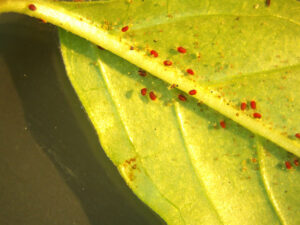
Spider mites
Spider mites are members of the Tetranychidae family. They are minute creatures, typically less than 1 millimeter in size, and are usually red, orange, or yellow. Common species include the two-spotted spider mite (Tetranychus urticae) and the spruce spider mite (Oligonychus ununguis)
Signs of Infestation
- Speckled Leaves: Spider mites feed on plant cells, leaving tiny yellow or white spots on leaves. By puncturing the surface and sucking the juices right out of them, the mite leaves it weakened and, eventually, kills the plant cells. making them useless to the plant for photosynthesis. Spruce spider mites (of course) prefer spruce trees, particularly Colorado blue spruce. However, they can also infest other coniferous trees, including juniper, fir, hemlock and pine.
- Webbing: Heavy infestations are characterized by fine, silken webs on plant surfaces.
- Discoloration and Wilting: Leaves may turn bronze, yellow, or brown and eventually drop off.
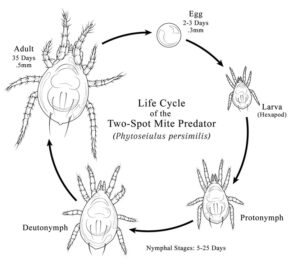
Two-Spotted Spider Mite Life Cycle
Life Cycle and Spread
- Spider mites thrive in hot, dry conditions.
- Females lay hundreds of eggs, leading to rapid population growth.
- They are easily spread by wind, garden tools, or infested plants.
Control Methods
Cultural Practices:
- Increase humidity around plants.
- Use a strong jet of water to dislodge mites.
- Remove and dispose of heavily infested plant parts.
Biological Control:
- Introduce predatory mites such as Phytoseiulus persimilis.
Chemical Control:
- Use miticides specifically labeled for spider mites, but rotate products to prevent resistance.
Broad Mites
Characteristics
Broad mites (Polyphagotarsonemus latus) are much smaller than spider mites and can be challenging to see without magnification. They have a wide range of host plants, especially peppers, but also eggplant, tomato and cucumber. They also affect many ornamental crops, including azalea, begonia, gerbera and cyclamen.
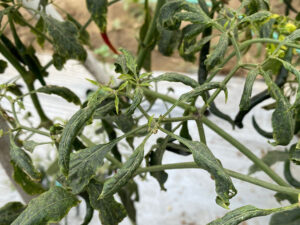
Broad mite damage
Symptoms
The damage caused by the broad mite can look similar to the damage caused by viruses. The typical pattern of damage consists of malformation and distortion of the above-ground growth of the plant. They prefer young, developing plant tissue, like the growing tips, young leaves and flower buds. Leaf feeding is mainly concentrated on the underside near the leaf stalk, which tends to cause the leaf to turn brown and curl up. When plants are severely attacked, the growing tip can be killed, plant growth stops and, in time, the whole plant dies off.
Management
- Prune and destroy affected areas.
- Apply horticultural oils or insecticidal soaps.
- Use predatory mites like Amblyseius swirskii for biological control.
Russet Mites
Russet mites, including the tomato russet mite (Aculops lycopersici), are microscopic pests that often go unnoticed until significant damage occurs.
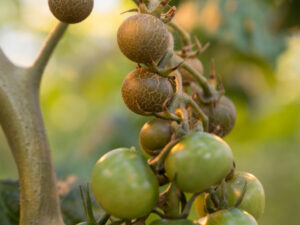
damage from Russet Mites
Damage
Damage is caused by the mites sucking out the contents of plant cells. Affected leaves are slightly curled and acquire a silvery sheen on the underside. Later they become brown and brittle. Badly affected tomato leaves and stems lose their trichomes (leaf hairs). Stems turn a rusty brown colour, and in serious cases they may snap. The fruit can also be affected, and when this happens in tomatoes, the skin becomes coarse and turns reddish brown and the fruit itself is sometimes deformed. Considerable damage can occur, especially at high temperatures when population growth is most rapid and affected leaves dry out quickly. The damage is first seen on the lower part of the plant and moves upwards as the mites ascend.
Control
- Remove and dispose of infested plant debris.
- Introduce beneficial predators.
- Use sulfur-based sprays, but avoid applying during high temperatures to prevent plant damage.
General Tips for Mite Management
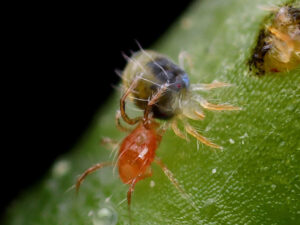
Phytoseiulus persimilis eating Spider Mite
Regular Monitoring:
- Inspect plants frequently, especially the undersides of leaves.
- Use a magnifying glass to detect early infestations.
Promote Beneficial Insects:
- Encourage natural predators such as lady beetles, lacewings, and predatory mites.
Maintain Plant Health:
- Provide adequate water and nutrients to reduce plant stress.
Avoid Broad-Spectrum Insecticides:
- These can kill beneficial insects, exacerbating mite problems.
Stay vigilant and employ integrated pest management techniques to minimize the damage caused by garden mites. Whether through cultural practices, biological controls, or carefully selected chemical interventions, there are effective strategies to protect your plants from these persistent pests, and hopefully stop being a pain in every gardener’s proverbial posterior.
A healthy, well-maintained garden is your best defense, so keep your plants strong, and the mites won’t stand a chance. Happy gardening everyone!


